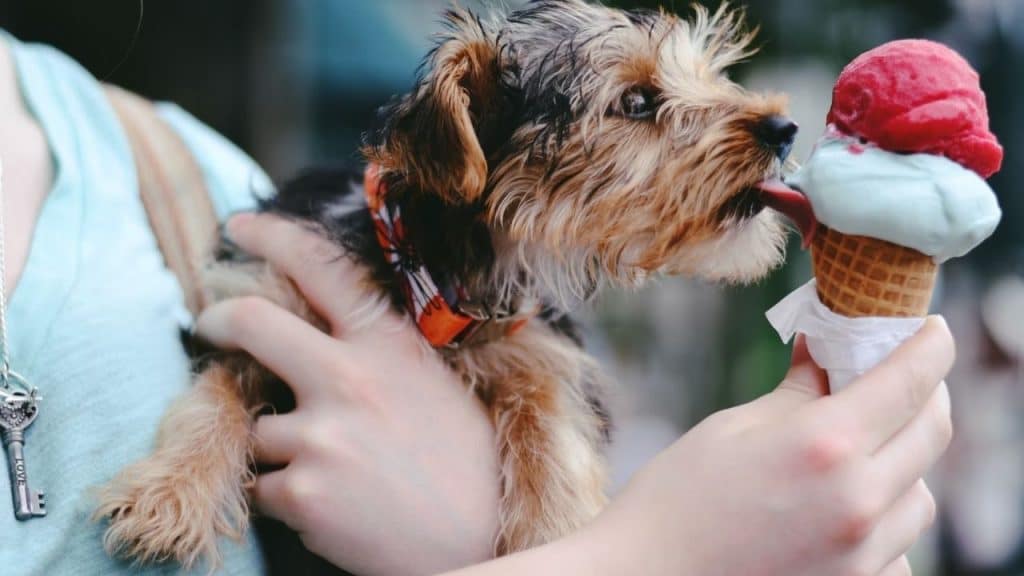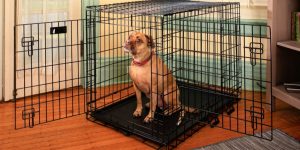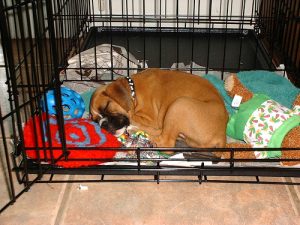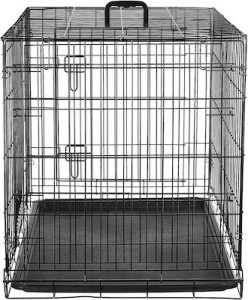Humans are often regarded as social animals, but this title may be better suited to “man’s best friend.” Dogs, by nature, crave company and attention because that’s the environment they’re born in.
That’s why puppies and adult dogs often cry when first introduced to the crate. It’s an awful experience for both owners and dogs. But, as you know, the dog crate is a good thing in the end.
There are dozens of reasons why dogs cry at night. It’s not always because of separation anxiety. Let’s look at how you can help your dog acclimate to the crate.
How do I get my dog to stop whining in his crate at night?
You can’t stop your doggo from crying in the crate, but you can create a welcoming environment. By gradually increasing the time they’re inside, your dog will soon love being in the crate.
1. Make the crate relaxing and interesting.
If their bed is the most comfortable part of the house, they are more likely to want to get into it for a nap and stay there once they’ve sat down.
Buy a decent bed which fits perfectly and is wrapped in their favourite blanket. Put their toys in there. Giving them a good chew toy can also help ease their anxiety and reduce tears.
NEVER give them any unsafe toys which can be torn apart easily and provide a choking hazard. Instead, give them something super strong such as a Kong classic.
In addition to a good cuddle toy, you can use scents your dog likes or try music therapy to help them sleep inside the crate. You can also resort to some drugs, but we’ll discuss that later.
2. Never overuse the crate and gradually increase the time.
If you want your pup to like the crate, then it’s important to use it only when necessary. This is especially important at the beginning so your dog doesn’t feel hatred and discomfort towards the crate. Forcing them to constantly be in it will accomplish the opposite.
Don’t put your dog in the crate for long consecutive hours if they’re not familiar with it, specifically if they’re just puppies. On the first couple of uses, your dog will likely cry because they want to come out and play.
However, we want them to learn that being in the crate is only temporary, and they may as well relax and sleep while waiting. Therefore, for your dog to get used to longer periods later and not cry, we recommend letting them in for increments which increase slowly over days and weeks.
For example, the first time, go with 10 minutes, then 20 minutes, 30 minutes, 45 minutes, 60 minutes and so on.

3. Let them eat, drink, wee, and poo before crate.
To eliminate the risk of your dog crying for food, you should either give them a meal before they go in or at least a treat they can enjoy. Separation anxiety isn’t the only cause of dog crate whining; hunger and dehydration are other big causes, too.
Don’t put water inside your dog’s crate. Growing dogs require plenty of water, but they must drink it outside the crate. Letting them drink inside will increase their wee time during the night and cause water intoxication if they drink too much too fast.
A crate is a highly effective tool for housebreaking – if you have the correct size crate, they won’t want to soil their sleeping area.
It will create serious anxiety if they are in the crate and need to relieve themselves. Your dog will be uncomfortable and desperate to wee and poo, but they wouldn’t want to soil their bed.
Avoid this by waiting until they’ve done their business before putting them in.
Read More: How often should you get a new dog bed? How to make the transition?
4. Don’t use the crate for punishments.
Discouraging unwanted behaviour is good, but don’t use the crate as punishment. If you use your dog’s crate as “jail,” then that’s what your furbaby will think of it.
We want to make the crate a happy place and give them no reason to want to cry.
Always leave the crate door open so your dog can wander in and out at leisure. It helps them to get used to it and that it’s simply a part of the furniture.
Another great idea is to periodically place treats in the crate when they’re not looking to encourage wandering in and out.
Positive reinforcement can also come into play here so that if they wander in, you heap praise on them.
5. Don’t disturb your dog during crate time.
Once they’re in the crate, leave them alone! Don’t check up on them too much as you could end up waking them up, and then you’ll have to deal with the fallout of that.
Another reason dogs cry and whinge inside a crate is because the world is so much better outside of it.
If the crate is placed in an area where people are always walking, your dog will be distracted. Avoid placing the crate in a high-traffic area in the house so that your dog can relax in peace.
6. Cover the crate up properly with blankets.
You can cover the crate from all sides properly with blankets to help them sleep. It makes your dog’s crate a dark and cosy den where they can relax peacefully.
We only used the crate for sleep and no other reason, though, so it may not work for owners who need to keep the dog in even if it’s not nap or bedtime.

7. Tire the dog out before putting them in the crate.
Putting a dog or puppy in a crate full of beans will likely make them upset and want to get out. A tired dog is a good dog, so you should try and tire them out before putting them, especially if it’s about to be a long stretch.
Why is my dog so stressed at night?
There are a lot of things that can stress a dog out during nighttime. Let’s look at the dogs’ most common causes of fear and anxiety.
1. Separation Anxiety
Most household pet dogs spend most of their early life with mothers and littermates before moving to our houses. And that’s what makes it so hard for them to make the switch.
Although their constant whining will make you second-guess your decision, you must stick to it. Your doggo is crying because of fear and loneliness. They miss the old family and are anxious about the new one.
Depending on your dog’s age, mental stress, and previous experiences, crate training can take several days to a couple weeks. The trick to successful crate training is to never rush your dog, as it could negatively affect their trust around you.
2. Lack of physical exercise
Dogs are hyperactive, so if they’re not mentally and physically tired by nap time, they’ll start getting anxious about going in the crate.
Senior dogs have as many problems inside a crate during nighttime as young puppies. If a senior dog suddenly starts barking and whining at night with anxiety symptoms, they’re likely in pain or suffering from cognitive dysfunction.
4. Physical pain
Your dog might be whining and barking because they aren’t comfortable inside the crate. It could be because of a general discomfort towards their bed and environment or underlying pain.
Health problems like toothache, rashes, and digestive issues can force a dog to whine at night, seeking help.
Read More: Beginner’s Guide to Preparing Dog Crates: What to add and where to put it?
How to help a dog with separation anxiety?
Recent studies have concluded that separation anxiety and dogs are caused by fear and stress of a new home and, more importantly, a lack of a coping mechanism.
A dog doesn’t magically stop whining after a successful crate training. It does so because they’ve developed trust, a sense of safety, and learned suitable coping techniques.
You have to be proactive and try to not let your dog suffer from separation anxiety in the first place. There are two ways you can go wrong in the beginning.
- Being together all the time: Like humans, dogs are creatures of habit. If you allow your dog to be with you every second of the day, they’ll grow to assume that as the norm. The sudden separation will stress out your dog when crate training begins.
- Overshutting your dog: If you lock a young puppy away for its first night, it’ll grow in fear and stress. More importantly, your dog will feel anxious around you instead of safe.

You must find the delicate balance between spending time together and helping them learn to be on their own. As I said, dogs are creatures of habit. So, if they get separation anxiety, get up and act fast. Some of the symptoms include:
- Crying at night,
- aggressive and destructive behaviour (chewing apart bedding and toys),
- pacing around before night,
- attempting to escape the crate,
- excessive panting, and
- self-mutilation (extreme cases)
Let’s look at the ways to efficiently deal with separation anxiety:
1. Get them accustomed to alone time.
Everyone knows you need to spend a lot of time with the new dog. But you should take constant breaks that are spread apart enough to keep the new member feeling safe.
Make sure to not leave at regular intervals or certain times, or your dog will start freaking out during that time of the day.
You can set up baby gates / dog gates around the house. Get your doggo engaged in an activity with a toy or another distraction, and leave the room. Before starting crate training, help them understand that they’re safe on their own in the new house.
By not making a big deal out of you or coming in at the beginning, you’re letting your dog know that it’s as ordinary as biting a chew toy.
2. Tire them out before bedtime.
Dogs are creatures of habit. If you make them engaged with a game or toys and tire them out by bedtime, you can put them in their bed. Your dog will learn to trust the crate more every time it wakes safely.
3. A mix of distance training and cold shoulder.
It breaks my heart to tell you that, but you’ll sometimes have to give your dog the cold shoulder. It’ll validate their insecurities if you rush over and make a fuss every time they whine at night.
Secondly, try distance training. Your dog shouldn’t sleep on your bed after a certain age or be far away on Day 1. Start by letting them sleep nearby and gradually increase the distance as your dog gets more comfortable with the arrangement.
4. Drug Therapy
Suppose your dog is suffering from a rather serious case of separation anxiety and mental stress. In that case, you’ll have to resort to medication.
However, never administer over-the-counter or any other medication unless your veterinarian specifically says so.
Why must you never punish a dog for crying at night?
I have had many furbabies over the years. So, trust me when I say everyone has a limit.
You can be as understanding and patient as you possibly can. Everyone breaks down after many nights of sleeplessness. But even then, punishment is a bad idea, counterintuitive even.
- You might cause them more stress: Let’s face it, your doggo is likely crying because they’re scared and stressed out. You’ll scare them further if you visit the crate in the dark only to scold and punish them. You have to help your dog put its trust in you, not make them afraid to be around you.
- You might validate your dog’s actions: Unless it has a specific problem, it’s either whining out of boredom or just craving attention. You’re giving them the attention they seek by rushing to the crate in the middle of the night. Sooner or later, your dog will develop a habit of whining at night just to get you to show up, even if it’s a negative response.
Instead of punishing your pup, understand their “why.” What is that making them so anxious and stressed? Of course, you can be stern with the pup and be commanding, as establishing hierarchy is also part of early house training.





